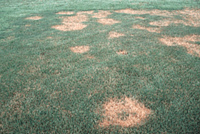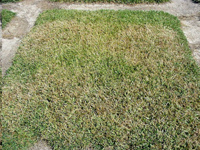Turf Diseases Most Common in Atlanta
Control of Landscape Pests and Turf Diseases that cause Lawn Damage
As the weather turns warmer and more humid, the activity of and damage from landscape pests and turf diseases can become a costly issue for Atlanta-area homeowners, businesses, and parks. Of most concern to most homeowners is damage to lawns from fungus activity. The most common turf diseases that affect our 3 most common types of turf grass are:
- Fescue Turf – Brown Patch Fungus: This fungus creates brown patches in the lawn, eventually causing grass to die, leaving bare spots.
- Zoysia Turf – Large Patch and Dollar Spot Fungi: Large Patch is the most damaging. As its common name implies, this fungus creates large dead patches in the lawn. Dollar spot gets its name from appearing as large Silver Dollar size spots throughout the lawn. This fungus weakens the thickness of the grass in these spots and looks unsightly.
- Bermuda Turf – Bermuda is fairly tolerant to most fungus damage but can have an issue with Dollar Spot.
Fungus is a microbe that already exists in our soils. Whether it becomes an issue in a lawn depends on several variables which include: 1) ability of the turf type to “fight” the fungus or as stated by growers “tolerate” the fungus, 2) the soil temperature that “wakes up” the fungus, 3) the moisture level of the soil surface and grass blades that are sufficient enough to support fungal growth.
Since fungus microbes are present in our soils, fungus can at best be only “controlled” but not “eradicated.” This means that lawns which exhibit fungus activity will usually have an issue with fungus every year. The best control is avoid over-watering from irrigation systems, and to apply an appropriate preventative or suppressing fungicide product just before and during the season of fungus activity.
Solterra Maintenance Clients have the option to be placed on a program that will include their property in the schedule for fungicide applications as the timing is appropriate. This program is outside of the standard lawn treatment programs which are setup to control weeds and fertilize lawns. Therefore, there is an additional charge for the fungicide program and is normally invoiced after each treatment has been applied. The number of treatments needed each year will depend upon the fungus type being treated and the weather conditions for that year. For Large Patch Fungus and Dollar Spot, the number of treatments needed is typically three (3). For Fescue brown patch, the number is typically five (5).
Contact Solterra’s Office or your Account Manager to have your property added for fungicide treatment.
The photos shown are from the UGA’s College of Agriculture and Environmental Sciences. Read an article about about turf disease here.





